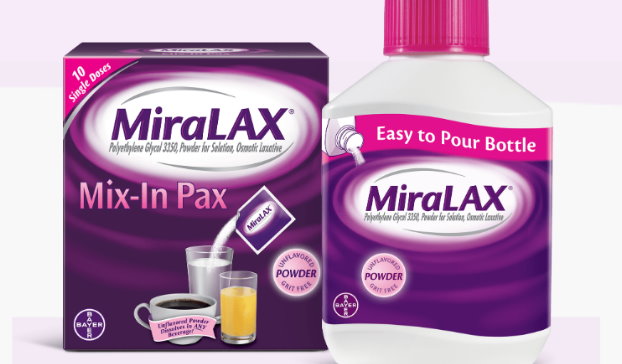Is It Safe To Take MiraLAX Everyday

MiraLAX is an osmotic laxative that works by drawing water into the colon to soften the stool and increase bowel movements. It is commonly used to treat occasional constipation and is available over the counter without a prescription. It is also used in preparation for certain medical procedures, such as colonoscopies.
Its active ingredient is polyethylene glycol 3350, which is an osmotic laxative. Polyethylene glycol 3350 works by drawing water into the colon to soften the stool and increase bowel movements. It is not absorbed into the bloodstream and does not affect the absorption of nutrients or medications in the digestive tract.
MiraLAX is available in a powder form that is dissolved in liquid and taken orally. The powder is tasteless and odorless, making it easy to mix with water or other beverages. MiraLAX does not cause immediate bowel movements and may take 1-3 days to produce a bowel movement.
In addition to polyethylene glycol 3350, MiraLAX contains small amounts of other inactive ingredients, including citric acid, potassium citrate, and sodium saccharin. These ingredients are used to improve the taste and stability of the medication and are generally safe for most people.
Can You Take MiraLAX Everyday?
Yes, MiraLAX is generally considered safe to take every day as long as you follow the instructions provided by your healthcare provider or the product label. However, it is important to note that MiraLAX should not be used for long-term treatment of chronic constipation without the guidance of a healthcare provider.
MiraLAX is intended for short-term use and should not be used for more than 7 days unless directed by a healthcare provider. If you continue to experience constipation after taking MiraLAX for 7 days, you should consult with your healthcare provider to determine the underlying cause of your constipation and develop a long-term treatment plan.
MiraLAX is typically taken once a day, usually at bedtime. The recommended dose for adults and children 17 years of age and older is 17 grams, or about one heaping tablespoon, dissolved in 8 ounces of liquid. Children 16 years of age and younger should use the dose recommended by their healthcare provider.
It is important to note that if you experience any unusual symptoms or side effects while taking MiraLAX, you should consult with your healthcare provider. Some of the common side effects of MiraLAX include bloating, gas, and diarrhea. If you experience severe or persistent side effects, such as severe abdominal pain or rectal bleeding, you should seek medical attention immediately.
If you are taking any other medications, it is important to talk to your healthcare provider before taking MiraLAX to ensure that there are no potential interactions or contraindications. In particular, if you are taking medications that affect your electrolyte balance, such as diuretics or heart medications, you should consult with your healthcare provider before taking MiraLAX.
What Side Effects Will Experience When I Take MiraLAX Every day?
MiraLAX is generally considered safe to take as long as you follow the instructions provided by your healthcare provider or the product label. However, like any medication, MiraLAX can cause side effects in some people.
Some of the common side effects of MiraLAX include:
1. Bloating
2. Cramping
3. Gas
4. Nausea
5. Diarrhea
6. Headache
These side effects are usually mild and go away on their own within a few days. If you experience any of these side effects while taking MiraLAX, you should continue taking the medication as directed unless directed otherwise by your healthcare provider.
In rare cases, MiraLAX can cause more serious side effects, such as:
1. Severe allergic reaction, including difficulty breathing, swelling of the face, tongue, or throat, and hives
2. Rectal bleeding or irritation
3. Electrolyte imbalances, which can cause symptoms such as muscle weakness, confusion, irregular heartbeat, and seizures
If you experience any of these more serious side effects, you should stop taking MiraLAX and seek medical attention immediately.
It is important to note that MiraLAX should not be used for long-term treatment of chronic constipation without the guidance of a healthcare provider. Long-term use of MiraLAX can cause electrolyte imbalances, which can be dangerous, especially for people with certain medical conditions such as kidney disease, congestive heart failure, or liver disease.
If you are taking any other medications or have any underlying medical conditions, it is important to talk to your healthcare provider before taking MiraLAX to ensure that it is safe and appropriate for you.
MiraLAX interactions
MiraLAX is generally considered safe and has very few known drug interactions. However, it is still important to inform your healthcare provider about all medications and supplements you are taking, including over-the-counter medications, prescription medications, and herbal supplements, to avoid potential drug interactions.
The followings are some medications and substances that may interact with MiraLAX:
1. Medications that affect electrolyte balance: MiraLAX works by increasing water in the colon, which can affect electrolyte balance. Medications that affect electrolyte levels, such as diuretics, may increase the risk of electrolyte imbalances when taken with MiraLAX.
2. Medications that slow down the movement of the digestive tract: Medications that slow down the movement of the digestive tract, such as opioids, may decrease the effectiveness of MiraLAX.
3. Antacids: Antacids may decrease the effectiveness of MiraLAX by neutralizing stomach acid and reducing the absorption of MiraLAX.
4. Nonsteroidal anti-inflammatory drugs (NSAIDs): NSAIDs, such as ibuprofen and aspirin, may increase the risk of gastrointestinal bleeding when taken with MiraLAX.
5. Warfarin: MiraLAX may increase the risk of bleeding when taken with warfarin, a blood-thinning medication.
6. Other laxatives: The use of other laxatives in combination with MiraLAX may increase the risk of electrolyte imbalances and dehydration.
7. Alcohol: Consuming alcohol while taking MiraLAX may increase the risk of dehydration and electrolyte imbalances.
It is important to note that this is not a comprehensive list of potential interactions. Always consult with your healthcare provider before taking any new medications or supplements with MiraLAX, and inform them of all medications and supplements you are currently taking. They can help you determine whether it is safe to take MiraLAX with your current medications and advise you on how to safely use the medication.
Conclusion
In summary, MiraLAX is generally safe to take every day as long as you follow the instructions provided by your healthcare provider or the product label. However, it is important to use MiraLAX for short-term treatment of constipation and not for long-term treatment of chronic constipation without the guidance of a healthcare provider. If you experience any unusual symptoms or side effects while taking MiraLAX, you should consult with your healthcare provider.




